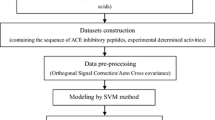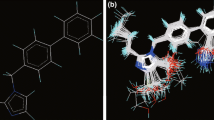Abstract
A novel set of descriptors G-scale was derived from 457 physicochemical properties of the natural amino acids. The descriptors were then applied to study on quantitative structure-activity relationships (QSARs) of nine peptide datasets of angiotensin-converting enzyme inhibitor (ACE-inhibitor) oligopeptides (between dipeptides and decapeptides) by using partial least square (PLS) regression. The multiple correlation coefficients (R2) and leave one out cross validation values (Q2) of PLS models are better than or close to the results of references. The results show that the descriptors proposed here may be a useful structural expression method, and they may be hopefully used in biological activity study of ACE-inhibitor oligopeptides.









Similar content being viewed by others
References
Phillips MI, Speakman EA, Kimura B (1993) Levels of angiotensin and molecular biology of the tissue rennin angiotensin systems. Regul Pept 43:1–20
Ondetti MA, Cushman DW (1982) Annu Rev Biochem 51:283–308
Hellberg S, Eriksson L, Jonsson J, Lindgren F, Sjostrom M, Skagerberg B, Wold S, Andrews P (1991) Int J Pept Prot Res 37:414–424
Bakulh HR, Shyam R, Asolekar (2001) QSAR models to predict effect of ionic strength on sorption of chlorinated benzenes and phenols at sediment-water interface. Water Res 35:3391–3401
Aleksandar Sablji C (2001) QSAR models for estimating properties of persistent organic pollutants required in evaluation of their environmental fate and risk. Chemosphere 43:363–375
Sneath PH (1966) Relations between chemical structure and biological activity in peptides. J Theor Biol 12:157–195
Kidera A, Konishi Y, Oka M et al (1985) A statistical analysis of the physical properties of the 20 naturally occuring amino acids. J Protein Chem 4:23–55
Hellberg S, Sjostrom M, Wold S (1986) The prediction of bradykinin potentiating potency of pentapep tides, an example of a peptide quantitative structure activity relationship. Acta Chem Scand B 40:135–140
Hellberg S, Sjostrom M, Skagerberg B et al (1987) Peptide quantitative structur activity relationships, a multivariate app roach. J Med Chem 30:1126–1135
Hellberg S, Eriksson L, Jonsson J et al (1991) Minimum analogue pep tidesets (MAPS) for quantitative structure-activity relationships. Int J Pept Protein Res 37:414–424
Sandberg M, Eriksson L, Jonsson J, Sjostrom M, Wold S (1998) New chemical descriptors relevant for the design of biologically active peptides, a multivariate characterization of 87 amino acids. J Med Chem 41:2481–2491
Collantes ER, Dunn WJ (1995) Amino acid side chain descrip tors for quantitative structure activity relationship studies of pep tide analogues. J Med Chem 38:2705–2713
Zaliani A, Gancia E (1999) MS-WHIM scores for amino acids: a new3D-descrip tion for pep tide QSAR and QSPR studies. J Chem Inf Comput Sci 39:525–533
Ramos De Armas R, Gonzalez-Diaz H, Molina R, Perez-Gonzalez M, Uriarte E (2004) Stochastic-based descriptors studying peptides biological properties: modeling the bitter tasting threshold of dipeptides. Bioorg Med Chem 12:4815–4822
Mei H, Liao ZH, Zhou Y, Li SSZ (2005) A new set of amino acid descriptors and its application in peptide QSARs. Biopolymers (Peptide Science) 80:775–786
Tian FF, Zhou P, Li ZL (2007) T-Scale as a novel vector of topological descriptors for amino acids and its application in QSARs of peptides. J Mol Struct Theochem 830:106–115
Tong J, Liu S, Zhou P, Wu B, Li Z (2008) A novel descriptor of amino acids and its application in peptide QSAR. J Theor Biol 253:90–97
Lin ZH, Long HX, Bo Z, Wang YQ, Wu YZ (2008) New descriptors of amino acids and their application to peptide QSAR study. Peptides 28:1798–1805
Shu M, Jiang Y, Yang L, Li Z et al (2009) Application of ‘HESH’ descriptors for the structure- activity relationships of antimicrobial peptides. Protein Pept Lett 16:143–149
Shu M, Mei H, Yang SB, Liao LM, Li ZL (2009) Structural parameter characterization and bioactivity simulation based on peptide sequence. QSAR Comb Sci 28:27–35
Yang L, Shu M, Jiang YJ, Mei H, Li Z (2010) ST-scale as a new set of amino acid descriptors and its application in QSAM of peptides and analogues. Amino Acids 38:805–816
Wold H (1985) Partial least squares in encyclopedis of statistical sciences. Wiley, New York, pp 581–591
Tenenhaus M (1998) La regression PLS theorie et pratique. Paris Editions Technip
Rose GD, Geslowitz AR, Lesser GJ, Lee RH (1985) Hydrophobicity of amino acid residues in globular proteins. Science 229:834–838
Wu JP, Aluko RE, Nakai S (2006) Structural requirements of angiotensin I-converting enzyme inhibitory peptides: quantitative structure–and–activity relationship study of di- and tripeptides. J Agric Food Chem 54:732–738
Cocchi M, Johansson E (1993) Amino acids characterization by GRID and multivariate data analysis. Quant Struct-Act Relat 12:1–8
Mei H, Zhou Y, Sun LL, Li ZL (2004) A new descriptors of amino acid and its application in peptide QSAR. Acta Phys Chim Sin 20:821–825
Zhou P, Zhou Y, Wu SR, Li B, Tian FF, Li ZL (2006) A new descriptor of amino acids based on the three-dimensional vector of atomic interaction field. Chin Sci Bull 51:524–529
Liang GZ, Zhou P, Zhou Y, Zhang QX, Li ZL (2006) New descriptors of amino acids and their applications to peptide quantitative structure activity relationship. Acta Chim Sinica 64:393–396
Wu JP, Aluko RE, Nakai S (2006) Structural requirements of angiotensin I-converting enzyme inhibitory peptides: quantitative structure-activity relationship modeling of peptides containing 4-10 amino acid residues. QSAR Comb Sci 10:873–880
Acknowledgments
This study was supported by the National Natural Science Foundation of China (No. 60873103), and supported by the Key Project of Natural Science Foundation of China (No. 30830090), Create new drugs national major projects (2009ZX09503-005), and the Foundation for the Author of National Excellent Doctoral Dissertation of P.R. China (200776).
Author information
Authors and Affiliations
Corresponding authors
Rights and permissions
About this article
Cite this article
Wang, X., Wang, J., Lin, Y. et al. QSAR study on angiotensin-converting enzyme inhibitor oligopeptides based on a novel set of sequence information descriptors. J Mol Model 17, 1599–1606 (2011). https://doi.org/10.1007/s00894-010-0862-x
Received:
Accepted:
Published:
Issue Date:
DOI: https://doi.org/10.1007/s00894-010-0862-x




